

Medicine wheel. Medicine wheel , or sacred hoop, are either a symbol of indigenous North American culture and religion, or stone monuments related to this symbol.

Paleo-Indians. Paleo-Indians (Paleoindians) or Paleoamericans is a classification term given to the first peoples who entered, and subsequently inhabited, the American continents during the final glacial episodes of the late Pleistocene period.

The prefix "paleo" comes from the Greek adjective palaios (παλαιός), meaning "old". The term Paleo-Indians applies specifically to the lithic period in the Western Hemisphere and is distinct from the term Paleolithic.[1] Evidence suggests big-animal hunters crossed the Bering Strait from Asia (Eurasia) into North America over a land and ice bridge (Beringia), that existed between 45,000 BCE–12,000 BCE (47,000 – 14,000 years ago).[2] Small isolated groups of hunter-gatherers migrated alongside herds of large herbivores far into Alaska. From 16,500 BCE – 13,500 BCE (18,500 – 15,500 years ago), ice-free corridors developed along the Pacific coast and valleys of North America.[3] This allowed animals, followed by humans, to migrate south into the interior. L'Anse aux Meadows. L'Anse aux Meadows ( / ˈ l æ n s i ˈ m ɛ d oʊ z / ; [ 1 ] from the French L'Anse-aux-Méduses or "Jellyfish Cove") is an archaeological site on the northernmost tip of Newfoundland in the Canadian province of Newfoundland and Labrador .
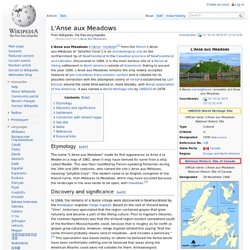
Discovered in 1960, it is the most famous site of a Norse or Viking settlement in North America outside of Greenland . Dating to around the year 1000, L'Anse aux Meadows remains the only widely accepted instance of pre-Columbian trans-oceanic contact and is notable for its possible connection with the attempted colony of Vinland established by Leif Ericson around the same time period or, more broadly, with Norse exploration of the Americas . It was named a World Heritage site by UNESCO in 1978. Etymology [ edit ] The name "L'Anse aux Meadows" made its first appearance as Anse à la Medée on a map of 1862, when it may have derived its name from a ship called Medée . Discovery and significance [ edit ] Fort Michilimackinac.
History[edit] The primary purpose of the fort was not military, but rather as a link in the French trading post system that stretched from the Mississippi River through the Illinois Country to the St.

Lawrence River. The fort served as a supply depot for traders in the western Great Lakes. Maya remains from 2,000 years ago found in southeast Mexico. Mesa Verde National Park. Spruce Tree House Long view of Spruce Tree House House of Many Windows Mesa Verde National Park is a U.S.
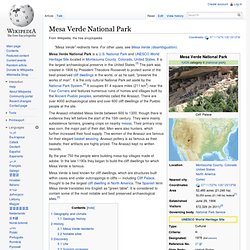
National Park and UNESCO World Heritage Site located in Montezuma County, Colorado, United States. Ancient Pueblo Peoples. Ancient Pueblo peoples or Ancestral Pueblo peoples were an ancient Native American culture centered on the present-day Four Corners area of the United States, comprising southern Utah, northeastern Arizona, northern New Mexico, and southwestern Colorado.[1] They lived in a range of structures, including pit houses, pueblos, and cliff dwellings designed so that they could lift entry ladders during enemy attacks, which provided security.
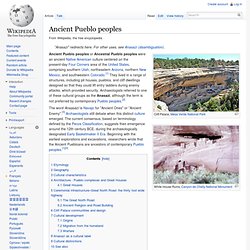
Archaeologists referred to one of these cultural groups as the Anasazi, although the term is not preferred by contemporary Pueblo peoples.[2] The word Anaasází is Navajo for "Ancient Ones" or "Ancient Enemy".[3] Archaeologists still debate when this distinct culture emerged. Fort Ancient. Fort Ancient is a name for a Native American culture that flourished from 1000-1750 CE[1] among a people who predominantly inhabited land along the Ohio River in areas of modern-day southern Ohio, northern Kentucky, southeastern Indiana and western West Virginia.
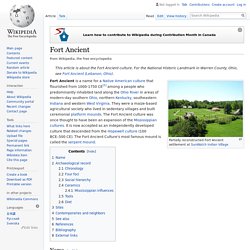
They were a maize-based agricultural society who lived in sedentary villages and built ceremonial platform mounds. The Fort Ancient culture was once thought to have been an expansion of the Mississippian cultures. It is now accepted as an independently developed culture that descended from the Hopewell culture (100 BCE–500 CE).
Medicine wheel. Cenote. A cenote (English: /sɨˈnoʊtiː/ or /sɛˈnoʊteɪ/; Spanish: [seˈnote]; plural: cenotes; from Yucatec Maya dzonot or ts'onot,[1] "well"[2]) is a natural pit, or sinkhole resulting from the collapse of limestone bedrock that exposes groundwater underneath.
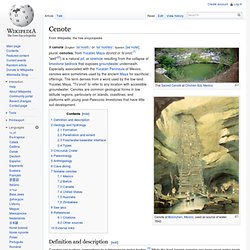
Especially associated with the Yucatán Peninsula of Mexico, cenotes were sometimes used by the ancient Maya for sacrificial offerings. The term derives from a word used by the low-land Yucatec Maya, "Ts'onot" to refer to any location with accessible groundwater. Cenotes are common geological forms in low latitude regions, particularly on islands, coastlines, and platforms with young post-Paleozoic limestones that have little soil development. Definition and description[edit] Cenote water is often very clear, as the water comes from rain water filtering slowly through the ground, and therefore contains very little suspended particulate matter.
Geology and hydrology[edit] File:Spreading homo sapiens.svg. Great American Interchange. Paleozoographic event resulting from the formation of the Isthmus of Panama Examples of migrant species in both Americas.

Olive green silhouettes denote North American species with South American ancestors; blue silhouettes denote South American species of North American origin.